| 18mm |
$949 average price |
|---|---|
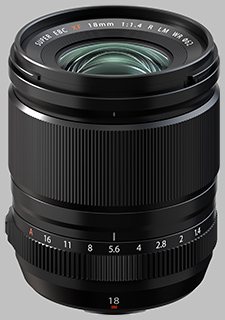
|
|
Your purchases support this site
Buy the Fujinon XF 18mm f/1.4 R LM WR
Updates:
07/13/2021: Gallery Images added
08/12/2021: Hands-on Review added (Gallery updated)
Fujifilm XF 18mm f/1.4 WR Hands-on Review
An excellent, if expensive, super-fast wide-angle prime lens
by William Brawley | Posted 08/12/2021
 |
|
X-T4: 18mm, f/1.4, 1/2700s, ISO 160
|
Back in April 2021, Fujifilm unveiled yet another fast prime lens to its already extensive arsenal of X-mount lenses. The new XF 18mm f/1.4 R WR lens slots right in between a pair of existing f/1.4 primes, a wider 16mm variety and a slightly longer 23mm lens. With the new 18mm lens, Fuji's overall "F1.4 Prime" family grows to four total lenses when you include the XF 35mm f/1.4 R lens, which debuted all the way back in 2012 with the X-Pro1. For X-mount photographers, the f/1.4 prime set now spans a very versatile range, offering excellent options for landscapes, portraiture, street photography and astrophotography pursuits.
Interestingly, the new XF 18mm f/1.4 lens sits right alongside an existing 18mm prime, the pancake-shaped XF 18mm f/2. The 18mm f/2 lens is smaller and lighter than the f/1.4 version and is significantly more affordable. The new XF 18mm f/1.4 isn't that much brighter than its ultra-compact sibling, but it is thoroughly weather-sealed, unlike the f/2 version. Plus, for those who want just that extra bit of low-light performance as well as shallow depth of field potential, the new XF 18mm f/1.4 answers the call.
 |
X-T4: 18mm, f/2.8, 1/1900s, ISO 160, -0.3EV |
Not long ago, I shared a batch of gallery images shot with the new Fuji XF 18mm f/1.4 lens after finally getting some hands-on time with a final production sample. I've now had some time to pen my thoughts and findings on how this fast yet lightweight prime lens performed in the field, so let's dive in!
Key Features & Specs
- 27mm-equivalent focal length
- f/1.4-f/16 aperture range
- 15 elements in 9 groups, including 3 aspherical elements and 1 ED element
- Linear motor AF system with 0.04s AF acquisition speed
- 11cm (4.3in) minimum focusing distance / 0.15x magnification ratio
- 9-bladed aperture diaphragm
- Manual aperture control ring
- Weather-sealed against dust, moisture and freezing temps down to -10ºC (14ºF)
- 62mm front filter thread
- Dimensions: 75.6mm Length x 68.8mm Diameter (2.98 in. x 3 in.)
- Weight: 370g (13.4 oz.)
- US$999
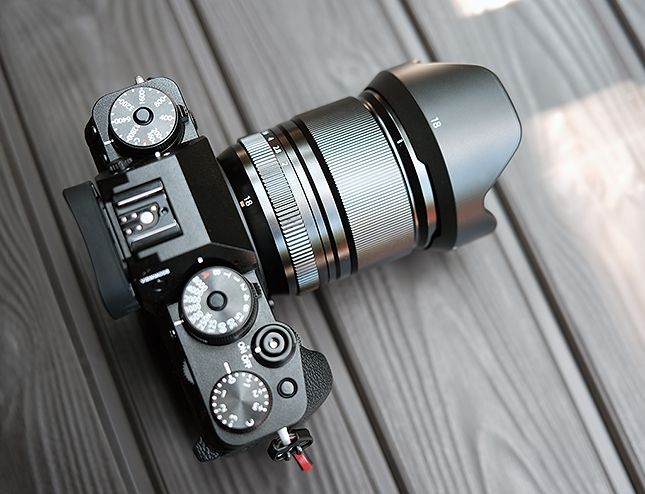 |
Design & Handling
As I referenced earlier, the new Fujifilm XF 18mm f/1.4 is, as one might expect, a bit larger and heavier than its not-as-fast 18mm f/2 pancake-sized sibling. Not counting the petal-shaped bayonet-mount lens hood, the XF 18mm f/1.4 lens is nearly three inches long and about three inches in diameter, whereas the pancake 18mm prime is not even two inches long and smaller in diameter. However, despite the faster f/1.4 aperture, the new XF 18mm lens is still impressively small and compact, as you can see in the photo below.
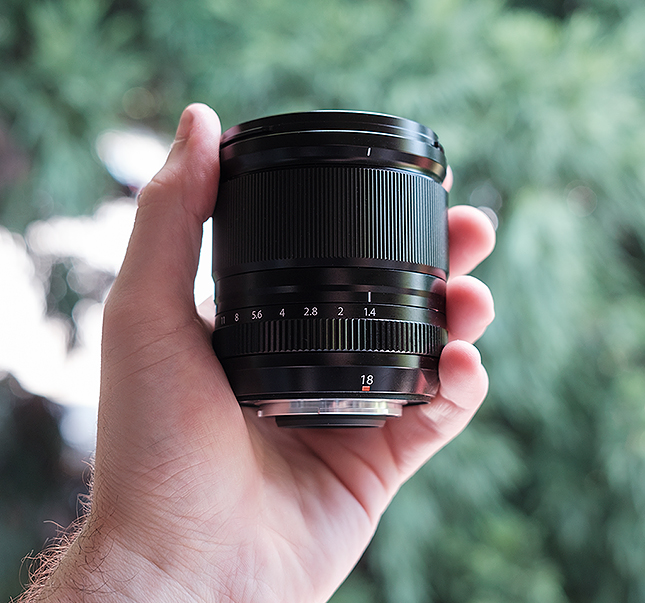 |
The build quality is very nice, with sturdy metal construction comprising the lens barrel and the two adjustable rings. The lens is also weather-sealed, as mentioned earlier. There are gaskets inside the barrel and a reasonably thick-looking gasket surrounding the metal lens mount. Overall, the lens feels very well built with a pleasingly solid heft to it (despite the minimal weight of the lens).
Speaking of weight, the XF 18mm f/1.4 weighs in at only 370g, making the lens still relatively light in the hand. Not surprisingly, it balances very well on the larger Fuji X-T4 body I used. The lens should also play nicely with smaller X Series bodies, such as an X-T30 or X-E4. It's a small, compact wide-angle prime lens; front-heaviness is not an issue. The lens is small and light enough that you can easily shoot one-handed if need be. But in regular two-handed shooting, the lens is conveniently small and well-designed to where I have comfortable and immediate access to the manual aperture ring and larger focusing ring.
 |
When it comes to what is essentially the only two external features of the lens -- the aperture ring and the focusing ring -- both operate as expected. The aperture ring offers marked full-stop aperture settings from f/1.4 to f/16 as well as clicked third-stop increments. The ring feels nice, too; the rotational and incremental clicks are light enough to easily adjust the aperture with just one finger if you want, but it's still decently stiff enough to prevent accidental aperture changes. That said, I wish the ring took a bit more force to rotate, just for an extra bit of reassurance.
There's also a locking "A" (automatic) aperture setting past the f/16 mark that will switch into an auto-aperture exposure mode (either Program Auto or Shutter Priority, depending the camera's dial settings). You need to press the aperture ring's lock button to move the ring into and out of the Auto position.
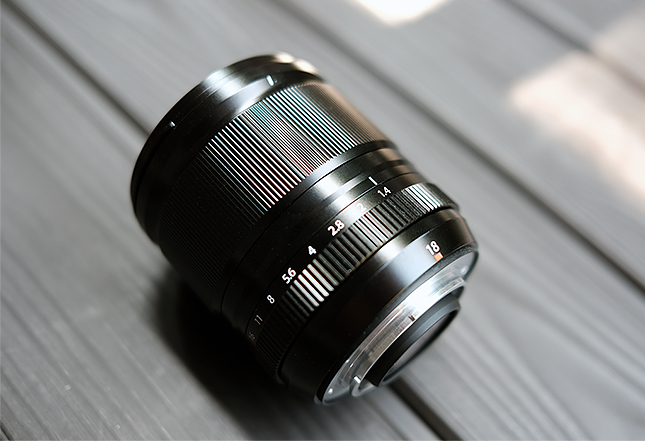 |
Focusing
The focusing ring rotates very smoothly, similar to what I've experienced with other Fujinon lenses. As a mirrorless lens, the focusing operation is all electronic; as with most mirrorless lenses, the focusing ring will rotate endlessly while in AF mode -- and also in Manual Focus mode, in the case of the XF 18mm f/1.4. There are no hard or soft stops at either end of the focusing range. There is also no physical AF/MF toggle switch on the lens itself; focus mode is controlled by the camera itself, which in the case of the X-T4 is a small lever on the front of the camera.
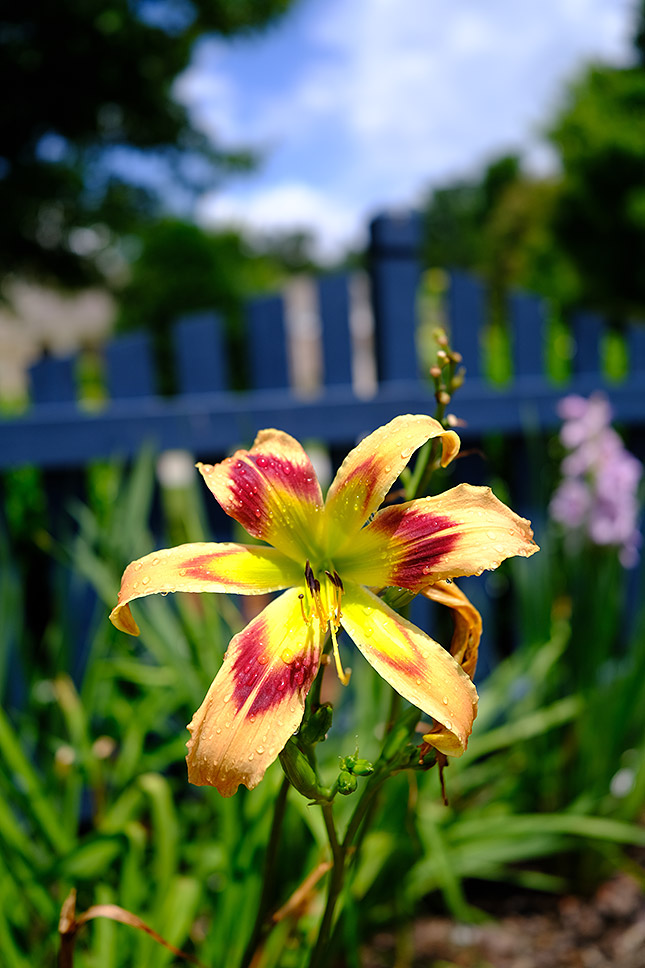 |
X-T4: 18mm, f/1.4, 1/8000s, ISO 160 |
In terms of the manual focusing user experience, I admit that I mainly shot with autofocus during my time with the lens (more of that in a bit), but when I did switch over to manual focus, I found the experience quite pleasant. The manual focusing ring does not have a "linear response," similar to a mechanically-linked focusing ring. In other words, the amount of focus change varies depending on the speed and/or velocity of the ring's rotation. For example, I can rack focus from close-focus to infinity with a little over 45 degrees of rotation but only if I rotate the ring very quickly. If I make a much slower, more deliberate focus adjustment, it'll take longer and take more rotation to rack through the full focusing range.
 |
X-T4: 18mm, f/1.4, 1/13000s, ISO 160, -0.3EV |
During typical shooting, however, the lens offers great manual focusing behavior. For small, controlled and precise manual focusing adjustment, the lens works very well. The focusing adjustments look and feel smooth and precise, without any noticeable "stepping" or jumping between focusing distances that I've seen with several other mirrorless or focus-by-wire lenses.
In terms of autofocus, the XF 18mm f/1.4 lens excels here, as well. The lens offers extremely fast and quiet AF performance thanks to its high-speed linear motor drive system. The lens is designed with a single focusing group of lightweight lens elements that only need to move about 2.5mm to rack through the entire focusing range. In other words, the focusing lens group is both small and doesn't have to travel very far for focusing adjustments, which results in swift focusing. Fujifilm states the lens can acquire focus in about 0.04 seconds, and while I've not been able to measure that figure precisely, the lens certainly feels like it focuses almost instantaneously -- especially with shorter focusing adjustments. Even autofocusing across the full focusing range from the minimum focusing distance to infinity is extremely fast, taking under a second.
 |
X-T4: 18mm, f/5.6, 1/1250s, ISO 160, -0.3EV |
An interesting side note -- one that's perhaps more of a nifty discovery about the X-T4 I used rather than with the lens itself -- but as expected, the XF 18mm f/1.4 doesn't offer any sort of focusing range limiter switch. A lack of such a feature isn't uncommon on shorter, wider lenses such as this one; focusing distance limiters are typically seen on telephoto lenses, where restricting the focusing range can help with AF speed and performance when photographing certain subjects. I noticed that the X-T4 offers the ability to limit the AF range of the attached lens, offering not only two presets (2m to infinity and 5m to infinity) but also a full customizable focus range. I never ran into any focusing issues where the lens got "stuck" in a certain focusing distance like can with some telephoto shooting situations, but the XF 18mm f/1.4 can focus quite close (down to 20cm), and it could be helpful to limit focusing to a specific range if you're working close up -- or vice-versa to prevent the lens from jumping to a close-up subject.
 |
X-T4: 18mm, f/1.4, 1/16000s, ISO 160, -0.3EV |
Image Quality
Overall, the new Fuji XF 18mm f/1.4 lens offers excellent optical quality, even when used at this super-fast f/1.4 aperture. It's challenging to make a lens with such a bright aperture also capable of sharp performance when used wide open, but the Fuji 18mm f/1.4 succeeds at this feat. Other aspects of image quality, such as chromatic aberration and vignetting, are also quite minimal.
The combination of a wide-angle field of view, good close-focusing and a fast aperture gives you the ability to make some interesting and dramatic close-up wide-angle photographs (and videos) with a shallow depth of field and nice subject isolation. It's a very cool look. Of course, this 27mm-equivalent prime is sharp and capable of other general-purpose wide-angle uses, such as landscapes and street photography, as well -- subjects that don't necessarily require a super-fast aperture. All in all, the new Fuji 18mm prime offers fantastic image quality performance.
 |
X-T4: 18mm, f/1.4, 1/4000s, ISO 160, -0.3EV |
Sharpness
In terms of sharpness, the Fuji XF 18mm f/1.4 is very sharp across much of its aperture range, including wide-open at f/1.4. Even at this super-wide aperture, the sharpness towards the center of the frame is impressively good. That being said, I found that the lens does sharpen up noticeably if you stop it down slightly. Stopping down just a bit to f/2 sharpens the center up just a bit if you look closely. However, for optimal sharpness, I found that the lens does best when stopped down to at least f/2.8. Sharpness continues to look outstanding at f/4 and down until about f/8. Once you hit f/11, I began to see slight softening due to diffraction, though it's nowhere near being considered unusable. However, at f/16 -- the lens's minimum aperture -- the lens is noticeably softer thanks to diffraction-related softness compared to the wider aperture. Again, I wouldn't consider f/16 unusable by any means, but if you want the best sharpness, I'd use a slightly wider aperture.
 |
X-T4: 18mm, f/1.4, 1/9s, ISO 160 |
f/1.4 - Center Crop (from RAW file) |
f/2 - Center Crop (from RAW file) |
f/2.8 - Center Crop (from RAW file) |
f/4 - Center Crop (from RAW file) |
f/5.6 - Center Crop (from RAW file) |
f/16 - Center Crop (from RAW file) |
(See the full series of sharpness test images in the Gallery.)
Out towards to corners, it's a similar story to what we saw at the center of the frame. Despite the wide-angle perspective, the XF 18mm f/1.4 lens is capable of decently sharp corners even at f/1.4, though it's certainly not tack-sharp. Of course, as expected, corner sharpness benefits from stopping down slightly. To my eye, stopping down to at least f/4 offers the best corner sharpness, and sharpness again remains very sharp until about f/11. Corners begin to appear a bit soft at f/11, and then much more so once you hit f/16.
f/1.4 - Corner Crop (from RAW file) |
f/2 - Corner Crop (from RAW file) |
f/2.8 - Corner Crop (from RAW file) |
f/4 - Corner Crop (from RAW file) |
f/5.6 - Corner Crop (from RAW file) |
f/16 - Corner Crop (from RAW file) |
Vignetting & Chromatic Aberration
Wide-open, the Fuji XF 18mm f/1.4 lens shows a very mild amount of vignetting. It's a subtle corner shading and not very distracting to my eye. In my opinion, some vignetting, especially at f/1.4 when there's often a very shallow depth of field and heavily blurred out-of-focus areas, is not distracting or problematic. If needed, it's easily correctable in modern editing/post-processing software, however. Outside of software, though, stopping down to around f/2.8-f/4 essentially eliminates any noticeable vignetting.
 |
X-T4: 18mm, f/1.4, 1/8500s, ISO 160, -0.3EV |
 |
X-T4: 18mm, f/2.8, 1/2200s, ISO 160, -0.3EV |
Similarly, chromatic aberration was hardly an issue with this lens. I had to shoot in very direct, very bright backlit situations in order to see any form of CA or purple fringing on high-contrast edges -- and even then, it was very minimal when looking close at un-corrected raw files. It's very possible that there is some in-camera processing at play here to help correct or suppress aberrations, but suffice it to say, the end results look excellent.
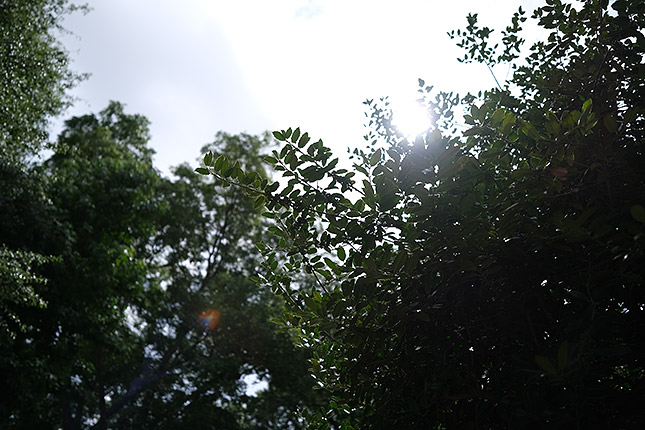 |
X-T4: 18mm, f/1.4, 1/9000s, ISO 160 |
 |
100% Crop from RAW file |
Summary
All in all, the new Fujifilm XF 18mm f/1.4 R WR is another solid addition to Fuji's already-expansive prime lens lineup. While Fuji already offers an 18mm prime lens, this new f/1.4 provides a few more features and amenities over the older, pancake-style 18mm f/2 lens, most notably weather-sealing and a slightly brighter aperture. At $1000, this is a pretty pricey lens, and a fairly noticeable price jump from the $600 XF 18mm f/2 (though $600 isn't cheap, either). The image quality performance from the XF 18mm f/1.4 is certainly impressive, as is the autofocus and the overall handling and build quality. Personally, I'm not sure it's worth the upgrade if you already own and are happy with the 18mm f/2 lens, unless you really need the weather sealing. Depending on what you tend to shoot, especially if you're often out in harsh conditions, having that extra reassurance in the construction could be an important deciding factor. An f/2 aperture is also likely plenty bright for all but the most demanding low-light shooting scenarios.
 |
X-T4: 18mm, f/1.4, 1/30s, ISO 160 |
But, if you need an 18mm prime lens for your Fujifilm camera, and you want the best one -- one with excellent image quality, fast AF, amazing low-light and shallow depth-of-field potential and weather sealing -- then the new Fuji XF 18mm f/1.4 will fit the bill quite nicely.
• • •
Product Overview
(From Fujifilm lens literature) FUJIFILM North America Corporation is pleased to announce its FUJINON XF18mmF1.4 R LM WR lens (XF18mmF1.4), expected to be launched in May, 2021. With a 35mm equivalent focal length of 27mm, and a maximum aperture of F1.4, it is the 39th lens in Fujifilm’s broad line of interchangeable lenses, made exclusively for the X Series family of mirrorless digital cameras.
Its lightweight, highly portable design makes it an ideal lens for everything from landscapes and cityscapes to portraits and weddings. Added flexibility in dimly lit environments is also provided through the lens’ wide F1.4 aperture, which also produces incredibly smooth bokeh.
Main features:
Exceptional optical performance, even at F1.4
- XF18mmF1.4 utilizes three aspherical lenses and an extra-low dispersion (ED) lens among its 15 lens elements, spread across 9 groups, to minimize chromatic and comatic aberration. This means the finest details of an image will be reproduced with high levels of sharpness.
- The focusing group of six lens elements moves in unison to minimize aberration fluctuations and deliver consistent sharpness at any focusing position.
Designed for versatility
XF18mmF1.4 has a 35mm equivalent focal length of 27mm and can achieve focus on subjects 4.33in (11cm) away from the front lens element. This gives the lens a broad range of applications, from making images of everyday moments, to using it to create sweeping landscapes.
Fast, accurate, and near-silent autofocus
XF18mmF1.4 uses an internal autofocus (AF) system, driven by a powerful linear motor, to provide fast, accurate, and near-silent AF. From the lens’ minimum object distance (MOD) of 7.87in (20cm) to infinity, the focusing group of lens elements travels a total of just 0.1in (2.5mm). This means focus can be acquired in as quickly as 0.04 seconds*1.
If the lens must travel beyond MOD to acquire focus, focus can still be achieved in as quickly as 0.25 seconds.
For precise control when manually focusing, components in the manual focusing ring assembly have been specially engineered to respond with precision, especially when the focusing ring is rotated slightly.
Compact, lightweight and weather-resistant
XF18mmF1.4 has a 62mm filter thread, measures 2.98in (7.56cm) in length, and weighs just 0.81lbs. (370g). This makes it incredibly lightweight and portable. While the lens barrel is made from metal, it is specially designed to minimize its weight without compromising its overall strength.
The lens has weather-resistant seals at eight locations along the lens barrel, making it resistant to dust, moisture, and temperatures as low as 14°F (-10°C) when used with a weather-resistant X-Series digital camera.
XF18mmF1.4 is designed with an A (Auto) Position Lock to lock the aperture ring into the A position, preventing accidental movement.
Optional accessory: LH-XF18 Lens Hood
Fujifilm has also developed a rectangular, aluminum lens hood for XF18mmF1.4 that helps to prevent lens flare and ghosting which can occur when beams of light strike the front element of the lens. The LH-XF18 Lens Hood will be made available in late May, 2021.
Pricing and Availability
FUJINON XF18mmF1.4 R LM WR Lens is expected to be available in late May, 2021 at a manufacturer's suggested retail price of $999 USD and $1,275 CDN. The LX-HF18 lens hood accessory will also be available at this time for a manufacturer’s suggested retail price of $69 USD ($80 CDN).
Fujinon XF 18mm f/1.4 R LM WR
Your purchases support this site
Fujifilm X-mount
Fujinon XF 18mm f/1.4 R LM WR User Reviews
The Fujinon XF 18mm f/1.4 R LM WR doesn't have any user reviews yet!